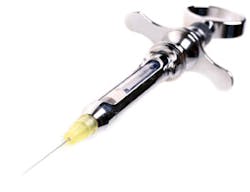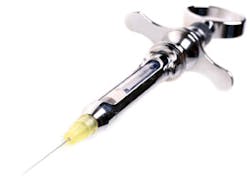"OUCH!!! -- I Just Got Stuck"
By Olivia Wann, RDA, JD
Needlesticks and sharps injuries are a serious hazard in the dental office. Such injuries may exposeThe Centers for Disease Control and Prevention estimates that health-care workers sustain 385,000 needlestick and other sharps related injuries in hospital-based settings annually. This amounts to 1,000 sharps injuries daily.
Gathering data in private practice settings such as dental offices is impossible due to a lack of a surveillance system. But it is suspected that including injuries in this setting would raise the total to more than 500,000.
The most common infections occupationally transmitted via sharps injuries during patient care include hepatitis B, hepatitis C, and HIV. The CDC also notes the risk includes herpes, malaria, and tuberculosis.
In 2000, I founded Modern Practice Solutions, a compliance firm that specializes in dental practices. Having been a dental employee, serving as a consultant, and now as an attorney, I understand the perspectives of dental workers and their employers and the challenges they face daily regarding safety. Our company analyzes workflow, audits documentation, and conducts hazard assessments.
We work with dental practices and have met hygienists and dental assistants who tell us they have experienced needlesticks and sharps injuries. Unfortunately, they did have a protocol in place to ensure proper follow-up as required by law. Some workers fear that an injury imputes poor work performance. Others fear the practice would incur an unnecessary expense.
Recently, the U.S. Department of Labor filed suit against a dentist in Massachusetts. The suit alleges the dentist fired an employee for filing a health hazard complaint with OSHA. According to the complaint filed in U.S. District Court in Boston, the dentist discharged a dental assistant in November 2010 after the employee raised concerns about an office procedure that required employees to remove protective caps from contaminated needles prior to disposal. The lawsuit seeks the employee’s reinstatement, payment of lost wages, benefits, interest, compensatory, and punitive damages.
An inspection resulted in the dentist being cited for eight alleged violations of OSHA’s
Bloodborne Pathogens and Standards. The dentist contested these citations, as well as and the accompanying $26,400 in proposed fines to the independent Occupational Safety and Health Review Commission. Employers feel the impact of costs related to post-exposure management of health-care personnel, which range from $500 to $3,000 per incident.
The goal of consultants is to promote safety. Remember, safety is not optional. Training, policy development, safer medical devices, and engineering controls are important components in compliance with OSHA’s Bloodborne Pathogens Standard and the promotion of worker safety.
According to the Organization for Safety, Asepsis and Prevention, four basic principles of infection control guide workers and patients toward safety. These principles include:
- Take action to stay healthy.
- Avoid contact with blood and bodily fluids.
- Limit the spread of blood and body fluid contamination.
- Make objects safe for use.
In analyzing the workplace, offices can make improvements by using a cassette system, such as IMS (Instrument Management System) by Hu-Friedy. Whether the dental office is struggling with space issues or trying to achieve greater organization and time management, practices can benefit from this system.
Above and beyond these benefits, practices can promote safety by using cassettes. The risk of worker injury is significantly minimized when instrument handling is reduced.
After use, the contaminated instruments are returned to the cassette, locked into place, and ready for transportation to the instrument processing area. The cassette is then ready for automated cleaning in an ultrasonic cleaner or dental instrument washer. This is followed by drying, wrapping/pouching, and heat sterilization. There is no more time wasted sorting instruments into pouches and searching for pouches to prep a tray.
Dental practices can minimize the risk of sharps injuries by avoiding the following safety hazards that are common in dental offices today.
- Not having the proper procedures in place, including step-by-step instrument management and instrument processing protocols.
- Working in a high-volume dental setting with insufficient time allotted for treatment room turnaround.
- Transporting loose instruments and sharps on trays through the office, risking bumping into another worker or patient. This is dangerous and can lead to a possible sharps injury that can be prevented with cassettes. According to the CDC, collision with a worker or a sharp represents 10% of the circumstances associated with needlestick injuries.
- Handling contaminated, loose instruments with patient exam gloves in the sterilization area rather than with heavy-duty, utility gloves.
- Using ponytail holders to retain instrument setups during instrument processing. This is a safety issue and prohibits effective cleaning between instruments during ultrasonic use.
- Improperly retrieving instruments and patient care items with contaminated, gloved hands in office cabinets and drawers. This is a common occurrence. Many times there are necessary instruments missing from the tray and the assistant must get up during a procedure to retrieve them.
Is this a cost burden or a money saver? In analyzing the investment vs. the expense, IMS actually saves money through time management. Valuable clinical staff time is best devoted to patient care and infection control rather than sorting instruments into setups. Additionally, practices save money by preventing breakage of instrument tips and loss of instruments as the cassette secures the instruments in place.
Reading about safety management is valuable, but the most beneficial insight is gathered by observing clinical team members in their working environment. In comparing offices that use cassettes with those that do not, I clearly see an improvement in minimizing sharps incidents. When implementing cassettes, such as Hu-Friedy’s IMS, you can save time, money, and promote safety among clinical team members.
Consider the following timely reminders to help close the gap in your office’s safety program and minimize the risk of sharps injuries:
- Provide annual training for staff on bloodborne pathogens, and retain documentation.
- Carefully review your sharps injury prevention program to include engineering and work practice controls.
- Update your work exposure control plan and ensure workers have access to it. Provide safer annual medical device evaluations.
- Implement a post-exposure management plan and carefully review the protocol with staff. Ensure medical records for employees are current, including documentation on hepatitis B vaccine status, post-exposure reports, and related documentation.
Safety training does not have to be boring. Encourage input from each team member whose perspective may provide valuable insight to the practice’s safety program. Whether you elect to work with a professional consulting company or launch a safety program, promote safety every day to ensure your dental health-care workers have long, healthy careers in dentistry.
For more information on infection control, go to www.osap.org.
References available from author upon request.
Olivia Wann, RDA, JD, attended Tennessee Technology Center as an RDA and graduated from St. Joseph’s College with a bachelor of science degree in health-care administration. She graduated from the Nashville School of Law, and is licensed to practice law in Tennessee. She founded Modern Practice Solutions in 2000. For more information, visit www.modernpracticesol.com or email [email protected].

